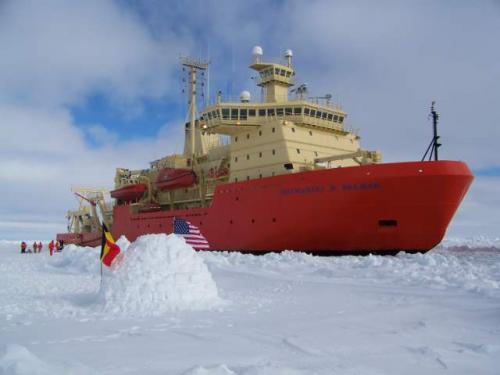Location: Ice Station Belgica
Latitude: 69° 31′ S
Longitude: **92° 23′ W
**Air temperature: -12.5 °C (9.5 °F)
Wind chill: -28.7 °C (-19.7 °F)
Wind speed: **11 to 13 knots
**Barometric pressure: 978.1
Antarctic trivia (answer at the end of this journal entry): The word igloo comes from the Inuit word "iglu" meaning house. What is it about an igloo that makes it a good shelter?
Steve thought it would be a good idea for our group to get a little safety and survival training Sunday morning, so Erik took us outside and taught us about the construction of snow shelters and igloos. It turns out that constructing an igloo is probably the most time consuming and least efficient way to build a structure to get out of the weather, but since we weren't doing it for anything other than fun, we decided that an igloo was the way to go. We learned how to quarry our snow "bricks" and lay them out to build a stable structure. The snow didn't always cooperate – it was quite dry and didn't stay together in blocks too well. The objective was to build large blocks that were the same size; I think most of our blocks were pretty small and no two were alike!
We cut the entrance to our igloo near the end of the day. Mike spent most of the afternoon constructing the igloo from the inside out, essentially trapping himself inside the structure. As the walls got higher Penny had to toss the snow bricks over the wall to him. Knowing that the structure would be stronger the next day, we suggested to Mike that he should just stay in the igloo overnight and we'd cut the door the next day. He wasn't too happy about that idea, even though we said we'd bring him a blanket and a hot dinner! Our igloo looks a bit more like a beehive than an igloo, but we don't think it's too bad for first-timers.

Our beehive-shaped igloo, claimed for America with Old Glory.
After shoveling snow most of the day, I feel pretty confident in my snow-shoveling ability despite my lack of previous experience. I can't say that all my bricks were well crafted, but I did move around a lot of snow in the process. Steve got the idea for our construction project when he saw an igloo that Jeremy built at one of the remote work sites. So, we really have Jeremy to blame, I mean thank, for our day of fun in the snow. Thanks, Jeremy…what's next – ice sculptures?

Jeremy looks out from inside his igloo during construction.
Monday morning the ship was repositioned to run a CTD cast from the starboard side of the ship. Most everyone took the late afternoon and early evening off to have an ice party. We took some group photos, played a little soccer on the ice, and enjoyed some time off. From my casual observations the Belgian members of our group seem to play soccer a lot better than the Americans on board. I think we need to challenge them to a game of real football…

The Belgian and American flags were flown at the igloo during the ice party.*
Answer to today's Antarctic trivia question: The word igloo comes from the Inuit word "iglu" meaning house. What is it about an igloo that makes it a good shelter?
Igloos not only provide protection from the wind, they are quite warm because snow is a good insulator. Air is trapped between the grains of the snow keeping the igloo's inhabitants warm. For the same reason, if you wear several thin layers of clothing instead of one heavy one you'll be warmer. I've found that three pairs of socks and three layers of gloves/mittens do the trick in Antarctica! The domed shape of the igloo also helped to retain heat.
Try this: Learn more about life in an igloo… Find out how the Inuit people adapted their igloos for the spring season. What type of home did they have in the summer? If their homes were made of snow, what were their beds made from? How were windows constructed in an igloo?
Marine mammals and seabirds spotted by Brent:
Minke whale
Crabeater seal
Southern fulmar
Antarctic prion
Antarctic petrel
Emperor penguin
Adelie penguin
That's all for now from Ice Station Belgica…I wonder what Steve has planned for us tomorrow!

